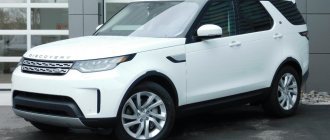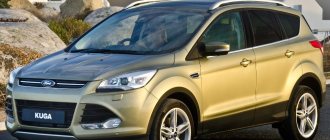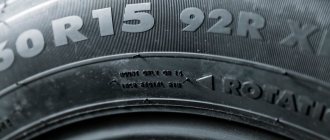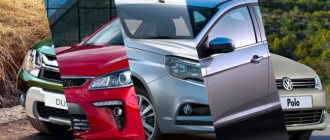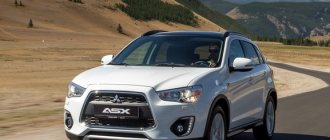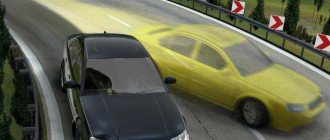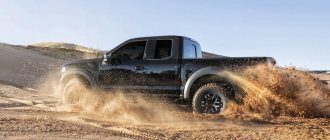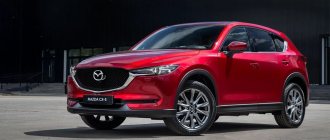Understanding what the SUV class is is not as easy as it might seem at first glance. Currently, this term is used by sellers to refer to a large group of SUVs, although in fact, SUVs are not SUVs. Another common name for SUV cars is jeep, although it is also not entirely correct, since the off-road characteristics of such cars are not complete, and they are not designed to overcome serious off-road conditions.
All SUVs have characteristics that are similar to standard passenger cars. But unlike ordinary passenger cars, the SUV class is more versatile and can easily perform specific tasks:
- carry a larger number of passengers, similar to minivans;
- transportation of heavy, oversized cargo;
- towing heavy trailers;
- overcoming difficult sections of the road that are beyond the reach of standard passenger cars.
A car for outdoor enthusiasts
The abbreviation SUV can be translated as a sports car, which is due to the fact that initially such cars were intended and actively used for transporting a variety of sports equipment - boats, bicycles, etc. Thus, cars of this class received a fairly high ground clearance, a spacious interior and roomy trunk. For the first time, the SUV classification was used, and starting from 1987, all all-wheel drive station wagons were classified as it.
Currently, SUVs include vehicles with sufficiently high ground clearance and a monocoque body. In addition, the drive of such cars is mostly all-wheel drive. This makes it possible to comfortably operate an SUV-class car in the city, and also allows you to overcome light off-road conditions - a trip to the country, a trip to the forest, etc. As a rule, on SUV-class cars, the all-wheel drive system is implemented based on a viscous coupling, so consider them full-fledged SUVs are wrong.
Crossover models and their platforms
| Model(s) | Platform |
| Acura MDX | Honda Odyssey |
| Audi Q7 | Audi A6 |
| Audi Q5/Audi Allroad Quattro | Audi A4 |
| Bentley Bentayga | |
| Škoda Octavia Scout | Škoda Octavia Combi |
| Škoda Yeti | Volkswagen A5 (PQ35) |
| BMW X3 | BMW 3 Series |
| BMW X6 | BMW X5 |
| Cadillac SRX | Sigma platform (Cadillac CTS/STS) |
| Chevrolet Captiva/Saturn Vue | GM Theta platform |
| Chrysler Pacifica | Chrysler CS platform (Chrysler Town & Country/Dodge Caravan) |
| Ford Ecosport | Ford B3 platform (Ford Fiesta) |
| Ford Flex | Ford D4 platform |
| Ford Escape/Mazda Tribute/Mercury Mariner | Ford CD2 platform |
| Ford Taurus X | Ford D3 platform (Ford Five Hundred/Taurus) |
| Ford Territory | Ford Falcon |
| Dodge Journey | Dodge Avenger |
| Buick Enclave/Chevrolet Traverse/GMC Acadia/Saturn Outlook | GM Lambda platform |
| Holden Adventra/HSV Avalanche | Holden Commodore |
| Holden Crewman/HSV Avalanche XUV | Holden Commodore |
| Honda CR-V | Honda Civic |
| Honda Element | Honda Civic |
| Honda Pilot | Honda Odyssey |
| Hyundai Tucson/Kia Sportage (2nd) | Hyundai Elantra |
| Hyundai Santa Fe/Hyundai Veracruz | Hyundai Sonata |
| Infiniti EX | Nissan FM platform |
| Infiniti FX | Nissan FM platform (Infiniti G35) |
| Jeep Compass/Jeep Patriot | Mitsubishi GS platform |
| Jeep Grand Cherokee WK2 (fourth generation) | Mercedes-Benz M-class (second generation) |
| Land Rover Freelander2(2006—2014)/Land Rover Freelander3(2015-) | Ford EUCD/LR-MS |
| Lincoln MKX/Ford Edge | Ford CD3 platform (Lincoln Zephyr/MKZ, Ford Fusion) |
| Mazda CX-3 | MAZDA SKYACTIV |
| Mazda CX-4 | MAZDA SKYACTIV |
| Mazda CX-5 | MAZDA SKYACTIV |
| Mazda CX-7 | |
| Mazda CX-9 | Ford CD3 platform |
| Mercedes-Benz GLK-Class | Mercedes-Benz C-Class |
| Mercedes-Benz M-class (third generation) | |
| Mitsubishi Endeavor | Mitsubishi Galant |
| Mitsubishi Outlander | Mitsubishi Lancer |
| Nissan Murano | Nissan D (Nissan Altima) |
| Nissan Rogue | Nissan C (Nissan Sentra) |
| Nissan X-Trail | Nissan C |
| Peugeot 3008 | Peugeot 308 |
| Renault Duster | Nissan B0 |
| Subaru Tribeca | |
| Suzuki SX4 | |
| Suzuki Grand Vitara/XL7 | |
| SsangYong New Actyon | |
| Toyota Kluger/Highlander | Toyota Camry |
| Toyota Harrier/Lexus RX | Toyota Kluger/Highlander |
| Toyota RAV4 | Toyota Celica |
| Volkswagen Tiguan | Volkswagen Group A platform (Volkswagen Golf) |
| Volvo XC60 | Volvo P24 platform |
| Volvo XC70 | Volvo P24 platform |
| Volvo XC90 | Volvo P2 platform (Volvo S80) |
From classic SUV to SUV class
The very first SUVs were characterized by the mandatory presence of a frame - it was the main load-bearing element, and it was on it that all components of the car, including the body, were attached. In severe off-road conditions, such a solution was optimal, but when operating in city conditions, with its smooth roads, the disadvantages clearly manifested themselves:
- not the easiest control when driving on a flat surface;
- heavy weight, which increases fuel consumption;
- passive safety is much less than that of cars of other classes, since the frame structure does not imply the presence of a deformation zone that softens the blow in a collision.
The need for a more economical and lightweight car was maturing quite rapidly, so development of a new concept began actively, which would retain the main advantages of an SUV, but would become much lighter, more comfortable and maneuverable. This can be considered the first step towards creating an SUV class car that retains certain off-road characteristics and loses its frame.
For SUVs, the type of suspension has also been changed. If an SUV could cope with any off-road conditions thanks to a dependent suspension, this turned out to be completely inappropriate for an SUV class car, which led to its replacement with an independent one - this significantly increased the comfort of movement on roads with smooth surfaces, and also had a positive effect on the car’s handling at high speeds. The all-wheel drive system has been changed and improved. Currently, most SUV class cars are equipped with automatically connected drive and locks.
SUV – advantages for the city
Thanks to the hard work of engineers, the new SUV-class of cars has become indispensable for the modern city dweller, who is no stranger to country trips in which he encounters washed-out country roads or snow-covered roads. Despite the fact that the SUV class is not designed to overcome serious obstacles, it has proven to be extremely popular among urban residents for a number of reasons.
- Recognizable, dynamic style of an SUV-class car.
- A fairly rigid body that is durable;
- Spacious interior and luggage compartment.
- Excellent handling and smoothness on roads with any surface.
- Reasonable price for a car with similar characteristics.
Among other things, owning an SUV-class car allows its owner to satisfy his own ambitions - to become noticeable and recognizable on the road. It is worth noting the maximum possible comfort of the interior, which is noted by both drivers and passengers of such cars. It was SUV class cars that turned out to be extremely in demand on domestic roads. They are sufficiently adapted to difficult climatic conditions and sudden changes in the quality of the road surface.
Depending on the manufacturer, SUV cars may also have additional options that have long been an integral part of real SUVs. These include differential locking - interaxle and between wheels located on the same axis. This allows you to more evenly transfer torque from the engine to all wheels. For comparison, in a standard passenger car, force is transmitted along the path of least resistance, so you can often see a situation where only one wheel is spinning, while the other three remain stationary. An SUV class car will practically not be able to find itself in such a situation.
decoding for tires, meaning in marking
In recent decades, crossover or SUV vehicles have become extremely popular. These cars combine the qualities of a well-known station wagon, and thanks to the increased ground clearance, the cars are designed for use both in the city and off-road.
Such cars belong to the SUV class - which means Sport Utility Vehicle or sports-utilitarian car. There is also a subclass SAV, the abbreviation stands for Sport Actlvity Vehicle - a car for active pastime. Such cars include BMW X6, Mercedes-Benz GLE Coupe, Porsche Macan.
However, only correctly selected tires will be able to unlock the full potential of the car when driving in off-road conditions or provide maximum comfort on asphalt. It is worth familiarizing yourself with what the symbols mean in the markings and the decoding of the symbols on the rubber.
What does the SUV label mean?
The fact that the tire is suitable for an SUV can be understood by the abbreviation suv printed on the sidewall. You can find it next to the model logo and the name of the manufacturer. As a rule, these tires come with additional markings such as AT or AW.
There are various SUV tires designed separately for winter or summer seasons, driving at high speed or driving on serious off-road conditions, for city SUVs or powerful SUVs. Each characteristic has its own designation, common to all brands. The ability to read labels will help you choose the best quality tires.
Tire classification
First of all, you should pay attention to the size of the wheels. These parameters can be applied in three different ways - according to the European specification or two American ones. European values are defined in millimeters and are the most common. The first parameter indicates the width of the tire, the second - the profile height in relation to the width, the third - the inner diameter. For example, if the designation for an SUV tire is 205*45*R17, then its tread width is 205 mm, the profile height is 45, and the suitable wheel rims are 17 mm in diameter. The letter R indicates that we are looking at products with radial cord weaving.
The first version of the American marking is reminiscent of the European classification, however, symbols have been added to the size that determine the orientation of the tires (P-Passanger, T-Rack, SUV and others).
Other markings use the inch designation system. The indicator 30*12*R18 means that 30 is the outer diameter, 12 is the tread width, and 18 is the inner diameter. This method is considered more convenient, because the profile height is not a constant value, while the outer diameter is constant. That is, a 185*45*R18 tire may simply not fit into the wheel arch when 165*45*R18 becomes normal.
Summer
Tire manufacturers of all brands produce shoes for cars for different seasons. Summer tires do not have a separate marking. If there are no icons on the wheel, then it is a priori considered summer.
The rubber compound of such tires consists of hard grades that can withstand high speeds and temperature loads. Then the mixture simply sticks to the asphalt, providing maximum grip. But at low temperatures (below +7), such tires simply “tan” and do not provide proper grip.
Winter
Winter tires work differently. In its production, soft varieties of rubber are used. This composition retains elasticity at negative thermometer values, and also has a branched tread pattern. This allows you to effectively remove water, dirt or slush without washing the tread.
All winter sets have their own icon in the form of a snowflake, indicating their direction. For modern jeeps, studded or non-studded winter tires are available. Spikes provide better traction on ice or compacted snow, but lose on normal roads. Therefore, if the car drives around the city, where snow is removed, then it is better to give preference to Velcro.
Velcro is divided into two types - European or Scandinavian. Tires differ in tread pattern. The first is aimed at mild winters, the second - at harsh ones. Thanks to the high profile, the suspension works a little softer, but the noise from the tread is higher than on summer sets.
Is SUV-class comfort worth the money?
Despite the presence of certain off-road characteristics, SUV-class cars are still not designed for really difficult conditions, since they do not have many of the characteristics of a real SUV. However, even when driving exclusively in urban areas, you can often find yourself in a situation where passenger vehicles are unable to overcome relatively small obstacles. For example, a sudden snowfall or blizzard often makes the movement of cars around the city very difficult.
In addition, trips out of town for a picnic or to the country may also be accompanied by the need to travel on not the best roads, and if the trip is made in rainy weather, similar difficulties may arise. In such situations, the SUV class turns out to be the most optimal car - the owner does not have to overpay for the serious off-road characteristics of a real jeep.
But at the same time, the car can easily cope with periodic movement along washed-out or swept-out sections of roads. One should not write off the sufficient level of comfort in the interior of a modern SUV-class car, which is quite comparable to the level of premium segment cars. Separately, it is worth noting that the SUV class is devoid of such disadvantages of a real SUV as a stiff suspension, high fuel consumption and unexpressed passive safety. An overview of one car of this class can be seen in the video:
Materials: https://mashintop.ru/articles.php?id=2544
